Music-Crash-Course-Treble-Clef-Ledger-Lines-Ebony-Ivory-Bass-Clef
Intro
Written music specifies to the musician(s):
Which pitches to perform - indicated by the vertical placement of notes on the stave,
When to perform these notes and How long to sustain each note:
Because the stave is five lines, it only has the capacity to indicate the pitch of notes within a limited range.
A clef sign is used to indicate what that range is.
The most often used clef is Treble Clef
Which pitches to perform - indicated by the vertical placement of notes on the stave,
When to perform these notes and How long to sustain each note:
Because the stave is five lines, it only has the capacity to indicate the pitch of notes within a limited range.
A clef sign is used to indicate what that range is.
The most often used clef is Treble Clef
Contents
Treble
Treble
 There are many clefs. Shown here is the Treble clef, also called the "G" clef. |
 Here is an enlarged view of the stave with the treble clef sign placed upon it. Also, the line which indicates the pitch "G (above middle C)" is labeled. Here is an enlarged view of the stave with the treble clef sign placed upon it. Also, the line which indicates the pitch "G (above middle C)" is labeled."Middle C" is a standard reference pitch. |
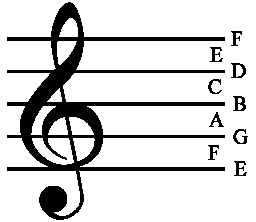 The lines and spaces which indicate other pitches (when the treble clef sign is used) are shown here. Notice that 'A' is above 'G'. The only pitch names used are: A,B,C,D,E,F & G. The lines and spaces which indicate other pitches (when the treble clef sign is used) are shown here. Notice that 'A' is above 'G'. The only pitch names used are: A,B,C,D,E,F & G. |
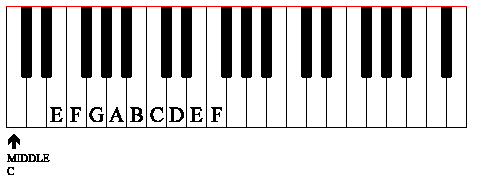 This partial piano keyboard has the names of the keys (all ivory) labeled that correspond the lines and spaces of the stave in treble clef. This partial piano keyboard has the names of the keys (all ivory) labeled that correspond the lines and spaces of the stave in treble clef.The keys on a piano keyboard are arranged in particular repetitive pattern. Notice how there are no ebony keys between 'E' and 'F' or 'B' and 'C'. |
Pitch and Stave
Pitch and Stave
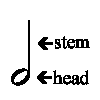 To indicate which pitch is to be performed, a note is placed on the stave. This particular note is called a half note. Each kind of note is represented by it's own specific symbol. The half note, like all other kinds of notes (except the whole note), has at least two parts; the head and the stem (some also have flags). In this example the stem rises vertically from the head on the right side. Sometimes the stem descends vertically on the left, depending upon the context in which it is used. To indicate which pitch is to be performed, a note is placed on the stave. This particular note is called a half note. Each kind of note is represented by it's own specific symbol. The half note, like all other kinds of notes (except the whole note), has at least two parts; the head and the stem (some also have flags). In this example the stem rises vertically from the head on the right side. Sometimes the stem descends vertically on the left, depending upon the context in which it is used. |
 Here the half note is placed on the stave, in this case indicating a "G (above middle C)". The reader of the music knows to perform the pitch "G". Here the half note is placed on the stave, in this case indicating a "G (above middle C)". The reader of the music knows to perform the pitch "G". |
 Here the pitch "F (above middle C)" is indicated in the same manner as the example above indicates "G". Here the pitch "F (above middle C)" is indicated in the same manner as the example above indicates "G". |
 Here a "D" is indicated. Notice how the stem descends vertically on the left. Although notes place on the upper half of the stave often have descending stems, there are several exceptions. Here a "D" is indicated. Notice how the stem descends vertically on the left. Although notes place on the upper half of the stave often have descending stems, there are several exceptions. |
Ledger Lines
Ledger Lines
 Ledger lines are used when there is a need to write pitches above and below the stave. A ledger line is a short line, just large enough to accommodate a note, used to temporarily extend the stave's range. Shown here is a single ledger line below the stave. Ledger lines are used when there is a need to write pitches above and below the stave. A ledger line is a short line, just large enough to accommodate a note, used to temporarily extend the stave's range. Shown here is a single ledger line below the stave. |
 Here are two ledger lines below the stave. Notice how they are as evenly spaced as the lines in the stave. Here are two ledger lines below the stave. Notice how they are as evenly spaced as the lines in the stave. |
 In theory, there is no limit to how many ledger lines can be used above or below the stave. However, for practical reasons, more than 3 are discouraged. In theory, there is no limit to how many ledger lines can be used above or below the stave. However, for practical reasons, more than 3 are discouraged. |
 This is a half note indicating "middle C". This is a half note indicating "middle C". |
Bass Clef
Bass Clef
 As mentioned before, there are several different clefs. Shown here is the Bass clef, also called the "F" clef. As mentioned before, there are several different clefs. Shown here is the Bass clef, also called the "F" clef. |
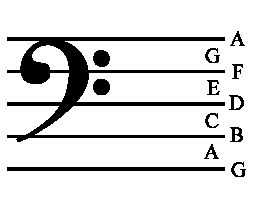 The lines and spaces with letters indicating pitches are shown here. The lines and spaces with letters indicating pitches are shown here. |
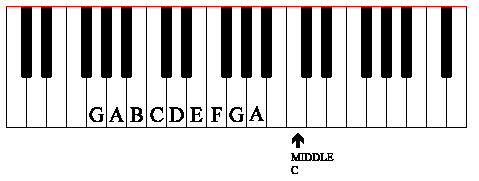 This partial piano keyboard has the names of the keys (all ivory) labeled that correspond the lines and spaces of the stave in Bass clef. This partial piano keyboard has the names of the keys (all ivory) labeled that correspond the lines and spaces of the stave in Bass clef. |
Ebony & Ivory
Ebony & Ivory
The lines and spaces of a stave refer to the Ivory keys.
The #(sharp) and b(flat) symbols are used to indicate pitches produced by the Ebony keys. When these symbols are placed directly in front of notes placed on the staff, they are called 'accidentals' - together these two symbols (an accidental and a note) indicate pitches which correspond to ebony keys.
Sharps and Flats are also used in key signatures.
The #(sharp) and b(flat) symbols are used to indicate pitches produced by the Ebony keys. When these symbols are placed directly in front of notes placed on the staff, they are called 'accidentals' - together these two symbols (an accidental and a note) indicate pitches which correspond to ebony keys.
Sharps and Flats are also used in key signatures.
 An enlarged view of the #(sharp) symbol is shown here as it appears in printed music. An enlarged view of the #(sharp) symbol is shown here as it appears in printed music. |
 An enlarged view of the b(flat) symbol is shown here as it appears in printed music. An enlarged view of the b(flat) symbol is shown here as it appears in printed music. |
 Shown here is F#. This indicates to the reader "find the note F and perform the pitch just above it". Shown here is F#. This indicates to the reader "find the note F and perform the pitch just above it". |
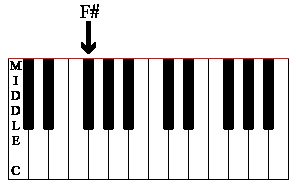 The same F# on a partial piano keyboard. |
 The same pitch could be shown as Gb. This indicates to the reader "find the note G and perform the pitch just below it". The same pitch could be shown as Gb. This indicates to the reader "find the note G and perform the pitch just below it". |
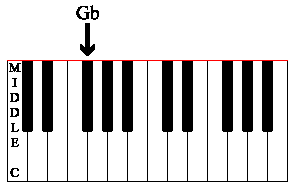 The same Gb, shown on our partial piano keyboard. The same Gb, shown on our partial piano keyboard. |
 The same use of the '#' and 'b' symbols applies to other pitches as well. Here is 'G#'. The same use of the '#' and 'b' symbols applies to other pitches as well. Here is 'G#'. |
 The same pitch written as 'Ab'. All pitches produced by the Ebony keys have two possible note names. The same pitch written as 'Ab'. All pitches produced by the Ebony keys have two possible note names. |
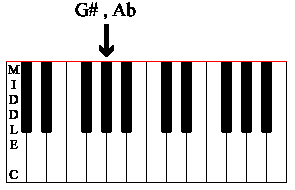 'G#' or 'Ab' Shown here on our partial piano keyboard. 'G#' or 'Ab' Shown here on our partial piano keyboard. |
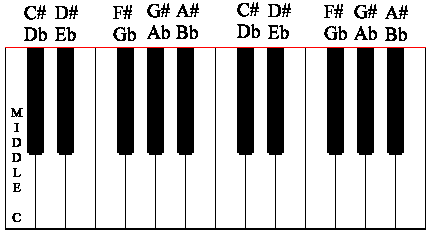 This keyboard has the Ebony keys label with the note names that could be used for each pitch. Which method (Sharp '#' or Flat 'b') is used depends upon the context in which the note appears. This keyboard has the Ebony keys label with the note names that could be used for each pitch. Which method (Sharp '#' or Flat 'b') is used depends upon the context in which the note appears. |

